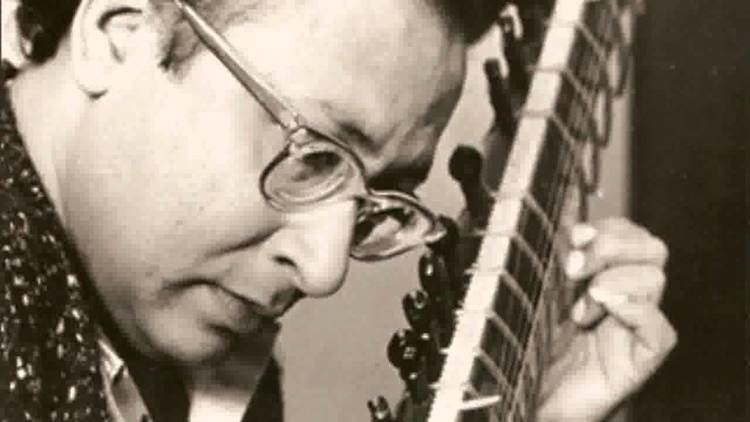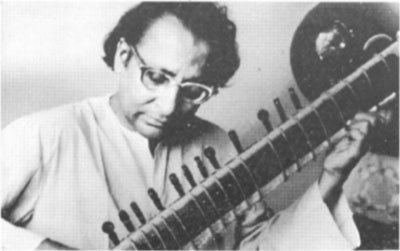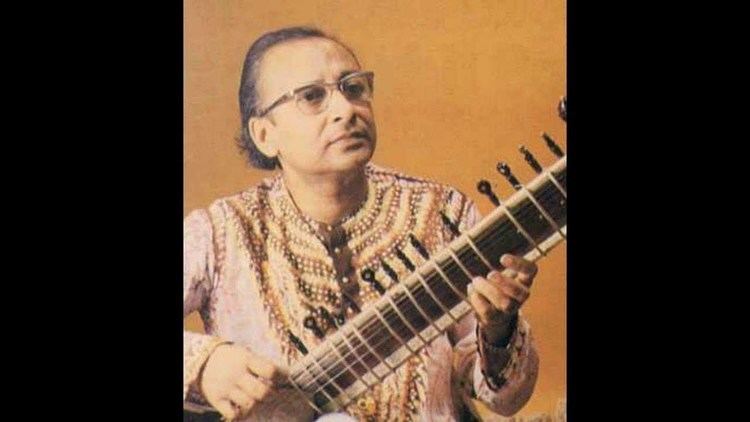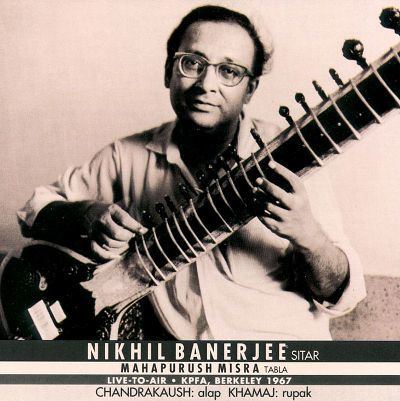Origin Calcutta, India Role Musical Artist Name Nikhil Banerjee | ||
 | ||
Born 14 October 1931 ( 1931-10-14 ) Awards Sangeet Natak Akademi Award for Hindustani Music - Instrumental (Sitar) Similar People Ali Akbar Khan, Abdul Karim Khan, Sabri Khan, Suhail Yusuf Khan | ||
Pandit nikhil banerjee raag marubehag 1980
Nikhil Ranjan Banerjee (Bengali: নিখিল রঞ্জন ব্যানার্জী) (14 October 1931 – 27 January 1986) was an Indian classical sitarist of the Maihar Gharana. A student of the legendary Baba Allauddin Khan, Pandit Nikhil Banerjee was known for his technical virtuosity and clinical execution. Along with Pandit Ravi Shankar and Ustad Vilayat Khan, he emerged as one of the leading exponents of the sitar. He was a recipient of the Indian civilian honour of the Padma Bhushan.
Contents
- Pandit nikhil banerjee raag marubehag 1980
- Raag mishra shivaranjani sitar recital by nikhil banerjee complete recording
- Early life and background
- The Maihar years
- Performing career
- Inspiration and critical acclaim
- Partial discography
- References

Raag mishra shivaranjani sitar recital by nikhil banerjee complete recording
Early life and background

Nikhil Banerjee was born on 14 October 1931 in Calcutta. His father, Jitendranath Banerjee, was an amateur sitarist and Banerjee was fascinated by his father's playing. Although he wanted to try his hand at an instrument as early as the age of four, he was discouraged by his father and grandfather. At the age of five, however, they relented and he acquired a small sitar, initially learning under his father. Banerjee grew into a child prodigy. He won an all-India sitar competition and became the youngest musician employed by All India Radio at the age of nine. Jitendranath approached Mushtaq Ali Khan to take Nikhil as a disciple, but only learned from this master for a few short weeks. Instead Birendra Kishore Roy Chowdhury, the zamindar of Gouripur in present-day Bangladesh, became responsible for much of his early training. He also had considerable training under Pt. Radhika Mohan Maitra, before he went under the discipleship of Ustd. Allauddin Khan.

Around 1946 Nikhil Banerjee met the great khyal singer Amir Khan through the master's teaching of Nikhil Banerjee's sister, and his enthusiasm for his music was reinforced by hearing him in concert a couple of years later. Amir Khan continued to have a significant influence on Banerjee's musical development.
The Maihar years

In 1947 Banerjee met Ustad Allauddin Khan, who was to become his main guru along with his son, Ali Akbar Khan. Both were sarod players. Banerjee went to Allauddin Khan's concerts and was desperate to have him as his teacher. Allauddin Khan did not want to take on more students, but changed his mind after listening to one of Banerjee's radio broadcasts. Allauddin Khan was Banerjee's main teacher, after he left Maihar he also learned from Ali Akbar Khan, the son of Allaudin Khan, for many years.
The discipline under Ustad Allauddin Khan was intense. For years, Nikhil's practice would start at four in the morning and, with few breaks, continue to eleven o'clock at night. Among others, Ustad Allauddin Khan also taught his son Ali Akbar Khan, grandson Aashish Khan, and nephew Bahadur Khan on the sarod; Ravi Shankar on the sitar; his daughter, Annapurna Devi, on the surbahar; Pannalal Ghosh on the flute; and Vasant Rai the sarod.
Ustad Allauddin Khan was passing on not only playing technique but the musical knowledge and approach of the Maihar gharana (school); yet there was a definite trend in his teaching to infuse the sitar and sarod with the been-baj aesthetic of the Rudra veena, surbahar and sursringar—long, elaborate alap (unaccompanied improvisation) built on intricate meend work (bending of the note). He was also well known for adjusting his teaching to his particular students' strengths and weaknesses. Consequently, under his teaching, Shankar and Banerjee developed different sitar styles.
Performing career
After Maihar, Banerjee embarked on a concert career that was to take him to all corners of the world and last right up to his untimely death. All through his life he kept taking lessons from Ustad Allauddin Khan and his children, Ustad Ali Akbar Khan and Smt. Annapurna Devi. Perhaps reflecting his early upbringing, he always remained a humble musician, and was content with much less limelight than a player of his stature could have vied for. Even so, in 1968, he was decorated with the Padma Shri, and in 1974 received the prestigious Sangeet Natak Akademi Award.
Nikhil Banerjee frequently toured Europe and the USA.
Although he was often resident at the Ali Akbar College of Music in California he taught few pupils on a one-to-one basis, for his stated reason that he did not feel he had adequate time to devote to his students, as he was still learning and performing. He hoped that developing a proper disciple relationship with students would become possible later in his life, but, sadly, his early demise meant it did not happen. Nevertheless, a number of prominent sitarists have been influenced by his teaching and distinctive style.
Banerjee recorded only a handful of recordings during his lifetime but a series of live performance recordings continue to be released posthumously making sure that his musical legacy is preserved for posterity. He did not always enjoy recording within the confines of the studio, though his early studio recordings with EMI India such as Lalit, Purya Kalyan and Malkauns are now considered to be classic renditions of these ragas. The posthumous live albums, many of which were brought out around the turn of the 21st century by Raga Records in New York, and Chhandadhara of Germany, are widely considered to be the finest documents of his playing. Many of his unpublished concert recordings are available which are testimony to his musical thought.
Nikhil Banerjee was in failing health through the 80s, having survived three heart attacks. On 27 January 1986, on the birthday of his younger daughter, at the relatively young age of 54, Nikhil Banerjee died of a fourth heart attack. At the time of his death, he was a faculty member at the Ali Akbar College of Music in Calcutta. He was posthumously awarded the Padma Bhushan title by the government of India in the same year as his death.
He is survived by his wife Roma and two daughters. His elder daughter is married into the Tagore family. His younger daughter Devdutta is a supermodel and acclaimed actress. Is widely accepted knowledge that he did not enjoy teaching nor accept formal disciples. .
Inspiration and critical acclaim
In an interview Nikhil said he had been influenced by Allauddin Khan, Ali Akbar Khan, Amir Khan, and to a lesser extent by Omkarnath Thakur, Faiyaz Khan, Kesarbai Kerkar, and Roshanara Begum.
For Banerjee, music-making was a spiritual rather than a worldly path:
"Indian music is based on spiritualism; that is the first word, you must keep it in your mind. Many people misunderstand and think it's got something to do with religion—no, absolutely no! Nothing to do with religion, but spiritualism—Indian music was practised and learned to know the Supreme Truth. Mirabai, Thyagaraja from the South, Haridas Swami, Baiju—all these great composers and musicians were wandering saints; they never came into society, nor performed in society."Nikhil Banerjee is revered for his mastery in both melodic and rhythmic aspects of Indian music. His unique style of sitar playing is considered to have completeness, emotion and depth. His interpretation of ragas was usually traditional, although he is credited with creating at least two new ragas. His usage of a completely "bandh" or "closed" jawari in the Maihar style sitar allowed for a much greater amount of sustain (since the strings are not buzzing against the bridge as much) as can be heard in his unique sound. Though his strings do not sound as "closed" as Ustad Vilayat Khan's sitar playing, it was only due to the technical differences in their physical sitars (and jawari was changed specifically for the Jor strings etc.) that the sitars sounded in "different" style.
According to the San Francisco Chronicle, Banerjee's "technique is a phenomenon, faster than cheetahs, more secure than the dollar." Music and Musicians observed that "his improvisations always sound completely natural and spontaneous." In an obituary the New York Times wrote "the extraordinary fluidity and assurance of his rhythmic ideas and phrasing set a standard that would have left the more international 'stars' of Indian music behind."
Today, he is commonly regarded as one of the greatest sitarists of the 20th century and is often spoken of as being on a level with the other two masters Ravi Shankar and Vilayat Khan.
Partial discography
The following is a summary of some recent CD issues. A more comprehensive discography can be found in the external links.
